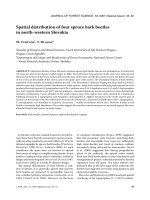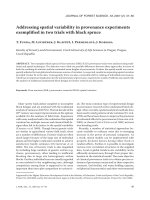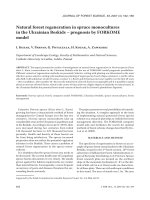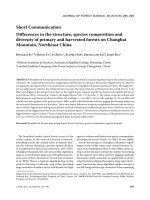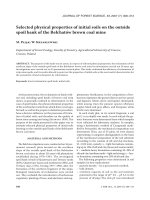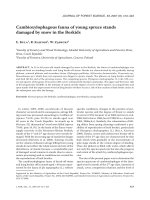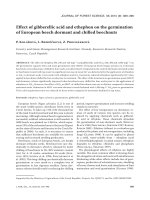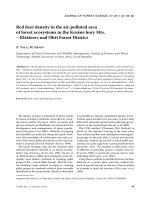Báo cáo lâm nghiệp: " Natural forest regeneration in spruce monocultures in the Ukrainian Beskids – prognosis by FORKOME model" ppt
Bạn đang xem bản rút gọn của tài liệu. Xem và tải ngay bản đầy đủ của tài liệu tại đây (817.82 KB, 8 trang )
162 J. FOR. SCI., 53, 2007 (4): 162–169
JOURNAL OF FOREST SCIENCE, 53, 2007 (4): 162–169
Extensive Norway spruce (Picea abies L. Karst.)
growing has been a characteristic method of forest
management for Central Europe over the last two
centuries. Norway spruce monocultures take up
considerable areas in the Ukrainian Carpathians and
in the Beskids. According to G (1978), their
area increased during two centuries from initial
126 thousand hectares to 325 thousand hectares
presently. Health and density of these forests are
far from being satisfactory. e spruce increased
proportion does not reflect the potential vegetation
schemes in the Beskids. ere arises a problem of
natural forest regeneration in the spruce mono-
cultures.
It is doubtless that the spruce forest area needs to
be decreased. e current health state of Carpathian
spruce forests documents it very clearly. e stands
grown against the habitat requirements are weaker
than natural forests. Consequently, a more frequent
occurrence of pests and diseases threatens the sur-
rounding forests seriously.
e paper presents several possibilities of remedy-
ing the situation. A complex approach to the issue
of implementing natural (potential) forest species
scheme on a research plot helps to rethink the forest
management direction. e FORKOME computer
model aids and facilitates the search for optimal
methods of forest scheme change described by K-
et al. (2003).
MATERIALS AND METHOD
e specificity of regeneration is shown on an ex-
ample of spruce forest research plots in the Ukrainian
Beskids, located in the 3
rd
forest section, 10
th
forest
subsection of Jabluneckie Forest Administration re-
gion of Borynsky Derzlishosp, Lviv Province. Spruce
forest research plots are located on the northern
slope of the mountain (inclination 6°–8°) at the alti-
tude of 650–652 m a.s.l. Brown soils are characteris-
tic of these plots. ere are rich euthropic conditions
in this stand. e area of stands was 1 ha. e area
Supported by the Polish Committee for Scientific Research, Project No. N 6 P06L 042 21.
Natural forest regeneration in spruce monocultures
in the Ukrainian Beskids – prognosis by FORKOME
model
I. K, V. P, G. P, H. K, A. Z
Department of Landscape Ecology, Faculty of Mathematics and Natural Sciences,
Catholic University in Lublin, Lublin, Poland
ABSTRACT: is paper presents the results of investigations on natural forest regeneration in Norway spruce (Picea
abies L. Karst.) monocultures in the Ukrainian Beskids with the use of FORKOME model prognostic possibilities.
Different variants of regeneration methods are presented. Selective cutting with planting was determined as the most
effective: spruce selective cutting with simultaneous planting of target species: beech (Fagus sylvatica L.) and fir (Abies
alba Mill.) with admixture of ash (Fraxinus excelsior L.). Beech and fir biomass increases rapidly over the first 20 years
– then it stabilizes. After another 20–30 years the initial form of beech forest is recognizable and it is possible to speak
about an increase of beech forest, which in the course of time achieves a higher degree of similarity to natural stand. In
the Ukrainian Beskids the potential forest stand consists of beech and fir (Dentario glandulosae-Fagetum).
Keywords: Norway spruce; beech; computer model FORKOME; Ukrainian Beskids; spruce monocultures; forest
management
J. FOR. SCI., 53, 2007 (4): 162–169 163
affected by felling – 625 m
2
. A near-by spruce stand
dominates the tree species beech composition. e
stand is characterized by the values of spruce (Picea
abies L.) diameter (dbh
1.3
) and height (H) (Fig. 1).
Spruce stand density is low (Fig. 2). It is also a single
species – only 1 fir per 38 spruce trees (Table 1).
Data on dbh and H was put into FORKOME model.
Prognoses were run with the use of FORKOME
model. e results of regeneration are presented for
N1 Norway spruce research plot. e FORKOME
model was presented and analyzed in detail in previ-
ous publications (K et al. 2002, 2003), so only
the general basis of the model is to be introduced in
this paper. FORKOME model represents the patch
model family used for simulating forest association
succession allowing single tree research. Two types of
analysis are possible to run with FORKOME. Statisti-
cal analysis includes the calculation of mean values
and standard deviations, while sensitivity analysis
concerns the calculation of auto- and cross-cor-
relation functions. e model enables site, species,
climate and felling parameters setting. e results
are saved and additional analysis by other computer
methods and programs is also possible.
Within certain scenarios (K, M
2001; K et al. 2003) the option of setting tree
felling mode, temperature and humidity conditions
is available. Monte Carlo statistic method allows to
simulate up to 200 variants of each scenario. e
model returns average number and average biomass
of trees with standard variation each year. To im-
prove the sensitivity analysis of forest ecosystems
auto- and cross-correlation functions are included.
Tree biomass and number of trees are important pa-
rameters in the calculations. Various charts present
relationships between these parameters for each
species, whole association and two ecological factors
(temperature and humidity).
Basic parameters for the FORKOME model are
listed according to species in Table 2. There are
adequate parameters with the proposed ones by
B (1999). e FORKOME model simulates
the dynamics of 5 chosen species that dominate on
the investigated plots (more are available).
FORKOME is an object system with basic compo-
nents: area – represents a current patch (gap), tree
– represents a single tree. e area object has its char-
acteristic properties: dimensions, habitat conditions,
climate conditions, etc. e user’s interface simplifies
the modification of patch properties. e area object
contains an almost unlimited amount of tree objects,
being representatives of already existing trees.
25
20
15
10
5
0
H (m)
0 5 10 15 20 25 30 35
dbh (cm)
y = 11.44Ln(x) – 17.186
R
2
= 0.8838
Fig. 1. N1 Norway spruce research plot:
dbh
1.3,
H relationship
Fig. 2. N1 Norway spruce research plot:
initial state in the FORKOME model
164 J. FOR. SCI., 53, 2007 (4): 162–169
e area object is formed in the system imitating
real world conditions (climate settings, tree felling).
e area object affects its tree objects by transmit-
ting information about current conditions e.g. light
availability to trees. is parameter is calculated
for certain height values in the patch. On that basis
Table 1. N1 Norway spruce research plot (25 m × 25 m)
GP Lp. tree Sp (No.) Species dbh H Age X Y
1 1 2 Picea abies 23 20.5 47 1.3 24.2
1 2 2 Picea abies 27 19.0 52 4.6 24.6
1 3 2 Picea abies 21 19.0 45 7.8 31.2
1 4 2 Picea abies 26 21.0 55 12.5 22.5
1 5 2 Picea abies 18 14.5 42 11.6 19.1
1 6 2 Picea abies 23 17.5 50 18.6 23.0
1 7 2 Picea abies 23 19.0 50 18.6 20.7
1 8 2 Picea abies 21 20.5 44 20.4 19.2
1 9 2 Picea abies 17 14.0 42 23.0 18.8
1 10 2 Picea abies 19 16.0 44 21.0 12.5
1 11 2 Picea abies 27 20.5 54 22.9 14.2
1 12 2 Picea abies 13 10.5 34 19.9 9.2
1 13 2 Picea abies 29 19.0 56 20.0 8.8
1 14 2 Picea abies 32 23.0 60 24.5 10.5
1 15 2 Picea abies 25 19.5 50 21.2 3.8
1 16 2 Picea abies 23 20.0 48 1.0 21.2
1 17 2 Picea abies 21 17.0 45 1.5 19.3
1 18 2 Picea abies 19 16.0 44 1.2 17.9
1 19 2 Picea abies 21 18.0 44 4.3 19.2
1 20 2 Picea abies 18 16.0 42 6.3 18.5
1 21 2 Picea abies 11 9.0 34 2.5 9.5
1 22 2 Picea abies 25 20.5 50 0.6 5.3
1 23 2 Picea abies 23 17.0 47 5.8 11.5
1 24 2 Picea abies 24 20.0 50 9.8 14.9
1 25 2 Picea abies 16 15.0 42 4.9 9.0
1 26 2 Picea abies 28 20.0 54 0.5 1.2
1 27 2 Picea abies 20 18.0 44 8.2 9.2
1 28 2 Picea abies 16 17.5 40 10.2 8.1
1 29 2 Picea abies 24 20.5 50 11.8 9.0
1 30 2 Picea abies 28 22.0 54 13.5 9.1
1 31 2 Picea abies 22 18.0 47 6.4 1.0
1 32 2 Picea abies 23 19.5 50 9.4 2.4
1 33 2 Picea abies 26 19.0 50 14.2 1.1
1 34 2 Picea abies 24 17.5 50 11.6 1.5
1 35 2 Picea abies 31 22.5 60 14.8 0.9
1 36 1 Abies alba 6 4.0 20 22.8 25.3
1 37 2 Picea abies 18 15.5 42 15.5 24.5
1 38 2 Picea abies 20 15.5 44 23.4 12.2
GP – area number; Lp. tree – tree number; Sp (No.) – species code; species – tree species Latin name; dbh – diameter at
breast height; H – height; age – tree age; X, Y – coordinates of the tree on the research plot
J. FOR. SCI., 53, 2007 (4): 162–169 165
tree growth simulation runs with one-year interval.
Within a single one-year simulation the area object
exercises the following calculations for existing trees:
input parameters (leaf area, moisture conditions);
growth; mortality; felling; regeneration. e preced-
ing year’s final state becomes an input state for the
following year.
In the FORKOME model the growth block de-
scribes tree growth on the current area for each
year simulating the real world. Each tree has its
genetically coded way of growth. Conditions the
tree is exposed to also influence the growth proc-
ess. FORKOME model’s trees are also described by
species-specific growth function, main parameters
(dbh, H, age) and external conditions (described
for each stand). Thanks to this solution, every Tree
object possesses the function of height. Simula-
tion of height imports itself to the creation of this
function on every tree providing parameters of
recent conditions in the given moment in a stand.
The basic simulation part consists in tree diameter
calculation. Annual diameter increment ranges
from 0 (minimal value) to ideal conditions value
(maximum for each species). The following equa-
tion is used:
DH
δ(D
2
H) = rLa
(
1 – ––––––––
)
D
max
H
max
where: r – species constant describing assimilation
apparatus photosynthetic productivity,
La – relative tree leaf area (m
2
/m
2
),
D – tree diameter measured at 1.30 m above the
ground (cm),
H – tree height (cm),
D
max
– species maximum diameter (cm),
H
max
– species maximum height (cm),
δ(
D
2
H) – tree volume increment (cm).
The influence of external conditions is taken
into account in tree annual increment. Real tree
increment δ(D
2
H)
real
is a result of optimal increase
δ(D
2
H)
opt
and tree growth inhibiting conditions f
1
, f
2
,
,f
j
, each value is ranged (0, 1).
δ(D
2
H)
real
= δ(D
2
H)
opt
× f
1
× f
2
× × f
j
where: δ(D
2
H)
real
– real tree volume increment, after consi-
dering the influence of external condi-
tions,
δ(
D
2
H)
opt
– tree growth optimum conditions,
f
1
, f
2
, ,f
j
– external conditions range (0, 1).
e equations are components of a multiplicative
approach.
Tree height is calculated with the use of tree di-
ameter;
H = 130 + b
2
D – b
3
D
2
where: b
2
, b
3
– parameters of each species are calculated
with the use of equations according to B-
et al. (1972):
H
max
– 130
b
2
=
2
(
––––––––––
)
D
max
H
max
– 130
b
3
=
(
––––––––––
)
D
2
max
Light availability is the most important external
factor that inhibits tree growth. e light amount
available to each tree is calculated in FORKOME
by considering the light radiation loss. e loss is
caused by the sum of shading by the leaf area of
higher trees. e radiation on each level of tree
canopy is registered with the use of a professional
tool for the patch.
e available light function describes the amount
of light available for specific tree leaves and is calcu-
lated according to the equation:
Q(h) = Q
max
E
–k×LA(h)
where: LA(h) – (Leaf Area) – leaf area above height h,
Q
max
– solar radiation measured on the tree tops,
Q
(h) – radiation measured at height h,
k – constant value – 0.25.
Trees are divided into 3 types depending on their
light tolerance index: sun tolerant, medium, shadow
tolerant.
e tree growth inhibiting light index is called light
reaction function and is calculated in two different
Table 2. Basic parameters of growth for the main tree species in the Beskids used in the FORKOME model
Tree species H max. (cm) D max. (cm) Age (years) B2 B3 G
Fagus sylvatica L. 4,500 150 300 58.26 0.194 290
Abies alba Mill. 6,000 150 400 78.26 0.261 200
Picea abies (L.) Karst. 5,500 150 400 71.60 0.239 370
Acer pseudoplatanus L. 4,000 150 300 51.60 0.172 160
Betula pendula Roth 3,500 100 100 67.40 0.337 540
Fraxinus excelsior L. 4,000 150 300 51.60 0.179 270
166 J. FOR. SCI., 53, 2007 (4): 162–169
ways depending on the tree light tolerating index.
Light demanding and medium species have the same
equations:
r = 2.24 (1 – e
–1.136[Q(h) – 0.08]
)
for shade-tolerant trees:
r = 1 – e
–4.64[Q(h) – 0.05]
where: r – light reaction function,
Q(h) – radiation at a given height.
ermal conditions of the model are described
by the annual sum of effective temperatures (higher
than 5°). The temperature index inhibiting tree
growth is calculated according to the equation below,
according to B (1993).
4(DGD – DGD
min
)(DGD
max
– DGD)
t = –––––––––––––––––––––––––––––––
(DGD
max
– DGD
min
)
where: t – growth inhibiting index,
DGD – sum of effective temperatures for a given
association,
DGD
min
– minimal sum of effective temperatures
required by the species,
DGD
max
– maximal sum of effective temperatures
required by the species.
FORKOME model also takes into account leaf
transpiration depending not only on meteorological
conditions but also on tree species like in the other
patch models. ere are also relations between the
tree species and groundwater level and between
the tree growth rate and availability of groundwater
implemented into the model structure. e block is
created on the basic water balance equation.
W(t + 1) = W(t) + Prec(t) – Trans(t) – Evapor(t)
where: W(t) – groundwater amount in the period of
time t,
Prec(
t) – precipitation,
Trans(
t) – transpiration,
Evapor(
t) – soil surface water evaporation.
Another tree growth inhibiting index is called SITE
INDEX. It describes the ratio of stem occupied area
to maximal available area (B 1993).
BAR
s = 1 – ————
SOILQ
where: s – tree growth inhibition site index, depend-
ing on the already tree occupied area,
BAR – total stem occupied area,
SOILQ – maximal stem area to be occupied on the
patch.
ere are two ways for a tree to die in the FORKOME
model. First, if the tree does not reach the minimal di-
ameter increment. Second, the tree dies randomly.
e model assumes that if during 10 consecu-
tive years the tree does not increase its diameter,
then there exists only a 1% chance that the tree will
survive the decade. Annual tree death probability
MORTAL is 0.386.
e FORKOME model studies if tree data get a
minimum increase. If the minimum value is not
exceeded, then random number (0.1) is taken, and
if that value is greater than MORTAL parameter, the
tree is removed.
Random tree mortality is based on an assumption
that only a part of healthy trees succeed to live their
maximal age. A FORKOME assumption is that 2% of
the trees reach their maximum age and so inequality
comes up described by B (1993):
4.0
RND < –––––––
AGE
max
where: RND – random number ranged (0.1),
AGE
max
– maximum tree species lifetime.
Trying to estimate the seed and sprout amount
of some species one encounters several problems.
Usually, the area all around the studied plot is
unknown, therefore that makes the seed amount
rather a guesstimate. at is the main reason for a
stochastic approach to the seed and sapling prob-
lem in the model. Research was carried out and an
empirical maximum amount of seeds and saplings
was collected for each of the model species during
one vegetation season. e amount is restricted by
random and available light on the ground level. e
amount of new saplings is generated separately for
each type of light tolerance.
For the block of nutrients we used a polynomial
function described by W et al. (1982).
FORKOME model provides a possibility of de-
fining felling scenarios. e interface supports de-
termining the time of felling and diameters of tree
species. e felling series can also be determined.
e block construction of FORKOME model allows
to use a wide range of climatic, soil and forest con-
ditions. e species included in the model are both
forest predominant species and admixed ones. e
future extended use of the model is also possible for
different scientific simulation experiments.
RESULTS AND DISCUSSION
ere are two main variants of reaching the natural
forest species composition. e first is a long-last-
ing one, assuming no anthropogenic interventions
in natural succession mechanisms. e FORKOME
prognosis reveals that the dominance of beech bio-
J. FOR. SCI., 53, 2007 (4): 162–169 167
mass over Norway spruce does not set over 100 years
of simulation time (Fig. 3).
e other variant (quicker result) assumes an-
thropogenic interventions of various extent, such as
felling or felling and planting.
e felling variant is characterized by a complete
cutout of spruce trees with dbh more than 4 cm. is
measure was performed in the 6
th
year of prognosis
with the FORKOME model. e results are as fol-
lows: beech biomass intensive increase to the level of
400 t/ha after 70 years of prognosis and spruce bio-
mass almost completely decreasing (Fig. 4). Such a
quick increase of beech biomass after 70 years in the
felling variant depends on rich site conditions and on
dominance of beech trees all around the spruce plot.
e felling and planting variant is a selective method
600
500
400
300
200
100
(t/ha)
0 50 100 150 200 250 300 350 400
Years
Fagus sylvatica
Acer pseudoplatanus
Picea abies
Abies alba
400
300
200
100
(t/ha)
0 25 50 75 100
Years
Fagus sylvatica
Acer pseudoplatanus
Picea abies
Abies alba
Betula pendula
Fig. 5. N1 Norway spruce research plot:
felling and planting management method.
General visualization
Fig. 3. N1 Norway spruce research plot:
biomass change prognosis. Natural suc-
cession
Fig. 4. N1 Norway spruce research plot:
biomass change prognosis. Felling man-
agement method
168 J. FOR. SCI., 53, 2007 (4): 162–169
of cutting spruce trees out. e method allows to
keep minimal shade, required by beech, fir (Abies
alba Mill.) and ash (Fraxinus excelsior L.) saplings.
Sapling density was assumed to be 6,000 specimen
of beech, fir and ash per 1 hectare described in
Zasady Hodowli Lasu… (2000). It is approximately
370 trees (beech – 127, fir – 117, ash – 120) per
25 m × 25 m research plot. e FORKOME model
imperfect visualization (Fig. 5) poses several program
problems, therefore the dimensions and bitmaps of
saplings do not fully correspond with the real ones.
ese minor visual inconveniences do not affect the
model working or prognosis results. Quick biomass
increase is simulated for this option (Fig. 6).
Beech and fir biomass increases in the first 20 years
of prognosis. Ash improves shaping the near-natu-
ral tree stand composition. It disappears just after
20 years, when beech and fir biomass stabilizes.
Within 30–40 years beech biomass reaches 400 t/ha
and holds the dominant position to the end of prog-
nosis. Fir biomass does not exceed 100 t/ha.
Each variant solves the issue of replacing spruce
stands with near-natural, habitat compatible forests.
Felling and planting scenario is the most suitable
one. There is often not enough time for natural
succession mechanisms to work or on the other
hand, the risk of a complete cutout is too great.
Selective cutting and planting target species mixed
with ash may be a solution uniting the advantages
and decreasing the risks of former variants. After
40–50 years a young beech-fir forest is developed,
its natural forest similarity approaching the potential
(Dentario glandulosae-Fagetum) forest association
in the Beskids Mts.
CONCLUSIONS
Presented results indicate high usefulness of the
FORKOME model while investigating natural forest
regeneration in spruce monocultures. e prognosis
indicates that the most effective method of regenera-
tion is spruce selective cutting and planting target
species of beech and fir with admixture of ash. Quick
beech and fir biomass increase and beech forest
development in the direction of natural (potential)
forest are characteristic in the prognosis. e for-
est continually evolves into the potential Ukrainian
Beskids beech-fir forest type.
R efere n c e s
BOTKIN D.B., 1993. Forest Dynamics: An Ecological Model.
Oxford, New York, Oxford University Press: 309.
BRZEZIECKI B., 1999. Ekologiczny model drzewostanu.
Zasady konstrukcji, parametryzacja, przykłady zastosowań.
Warszawa, Fundacja Rozwój SGGW: 115.
GOLUBETS M.A., 1978. Spruce forests in the Ukrainian Car-
pathians. Moskva, Naukovaja Dumka: 280. (in Russian)
KOZAK I., MENSHUTKIN V., 2001. Prediction of beech
forest succession in the Bieszczady Mountains using a com-
puter model. Journal of Forest Science, 47: 333–339.
KOZAK I., MENSHUTKIN V., KLEKOWSKI R., 2003. Mo-
delowanie elementów krajobrazu. Lublin, Towarzystwo
Naukowe KUL: 190.
KOZAK I., MENSHUTKIN V., JÓŹWINA M., POTACZAŁA
G., 2002. Computer simulation of fir forest dynamics in
the Bieszczady Mountains in response to climate change.
Journal of Forest Science, 48: 425–431.
WEINSTEIN D.A., SHUGART H.H., WEST D.C., 1982. e
long-term nutrient retention properties of forest ecosys-
tems: A simulation investigation. ORNL/TM-8472, Oak
Ridge National Laboratory, Oak Ridge, Tennessee.
ZASADY hodowli lasu obowiązujące w państwowym gospo-
darstwie leśnym, 2000. Warszawa, Lasy Państwowe: 176.
Received for publication April 4, 2006
Accepted after corrections October 9, 2006
600
500
400
300
200
100
(t/ha)
0 50 100 150 200 250 300 350 400
Years
Fagus sylvatica
Acer pseudoplatanus
Picea abies
Abies alba
Fraxinus excelsior
Fig. 6. N1 Norway spruce research plot:
biomass change prognosis. Felling and
planting management method
J. FOR. SCI., 53, 2007 (4): 162–169 169
Přirozená obnova lesa ve smrkových monokulturách ve Východních Beskydech
– prognóza s využitím modelu FORKOME
ABSTRAKT: Příspěvek přináší výsledky výzkumu přirozené obnovy lesa ve smrkových monokulturách (Picea abies
L. Karst.) Východních Beskyd s využitím prognostických možností modelu FORKOME. Byly předloženy různé
varianty obnovních metod. Jako nejefektivnější se projevila selektivní těžba s výsadbou – selektivní těžba smrku se
současnou výsadbou cílových dřevin: buku lesního (Fagus sylvatica L.) a jedle bělokoré (Abies alba Mill.) s dodá-
ním jasanu ztepilého (Fraxinus excelsior L.). Biomasa buku a jedle rostla velmi rychle v prvních dvaceti letech, pak
došlo k její stabilizaci. Po dalších 20–30 letech bylo již možné rozpoznat iniciální formu bukového lesa a stálý vývoj
(potenciálně) přirozeného lesa. Potenciální (přirozené) lesní porosty Východních Beskyd se skládají z buku a jedle
(Dentario glandulosae-Fagetum).
Klíčová slova: smrk ztepilý; buk lesní; počítačový model FORKOME; Východní Beskydy; smrkové monokultury;
lesní hospodaření
Corresponding author:
Prof. Dr. hab. I K, Catholic University in Lublin, Faculty of Mathematics and Natural Sciences,
Department of Landscape Ecology, Konstantynów 1H, 20-708 Lublin, Poland
tel.: + 480 814 454 531, fax: + 480 814 454 551, e-mail:
